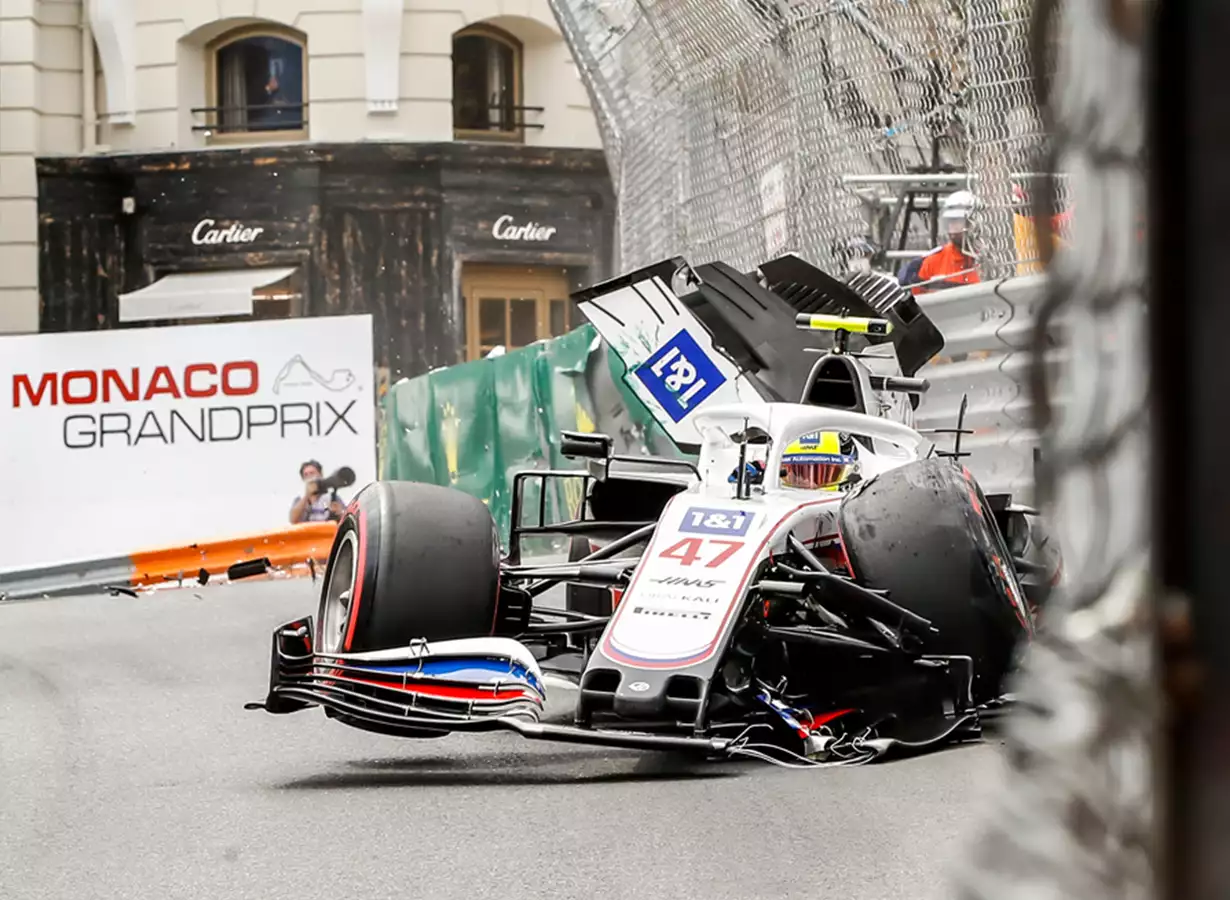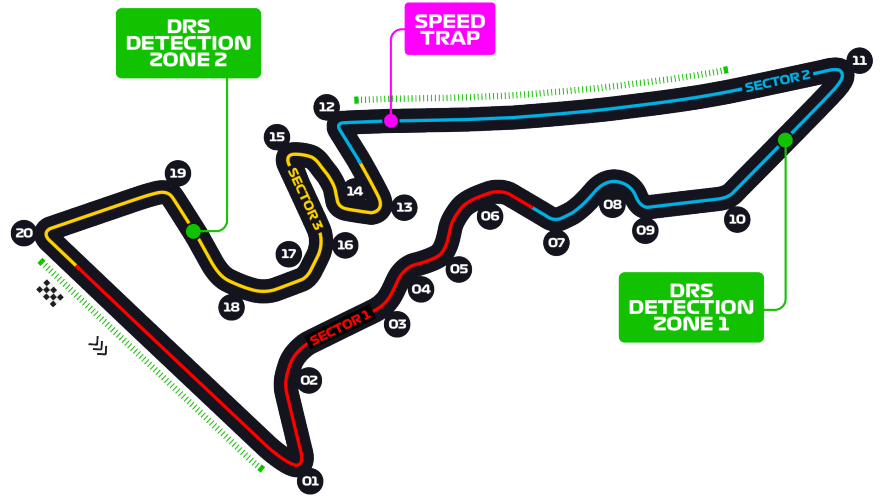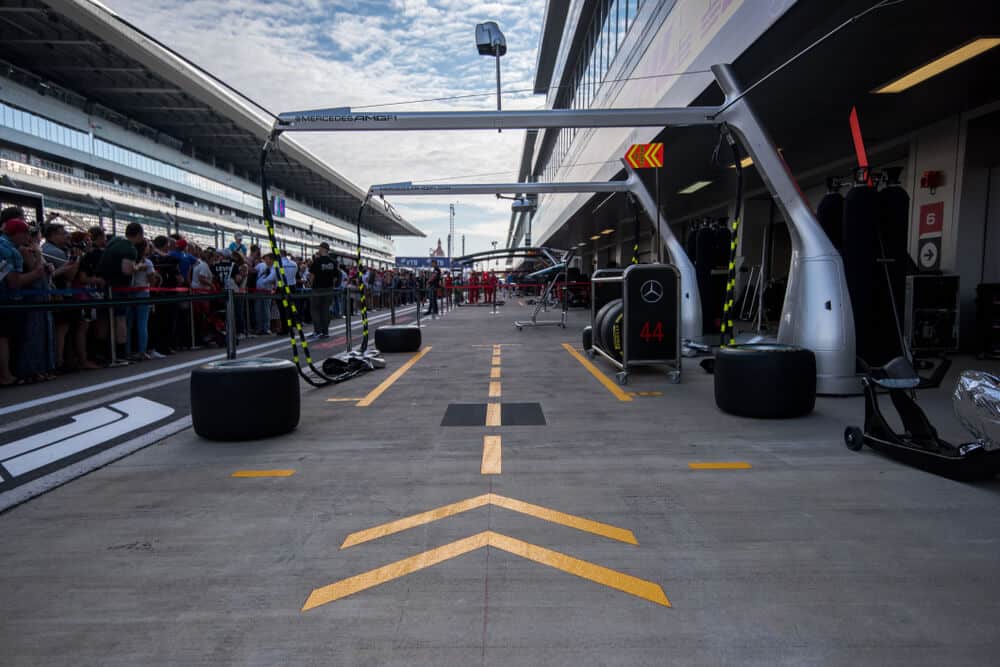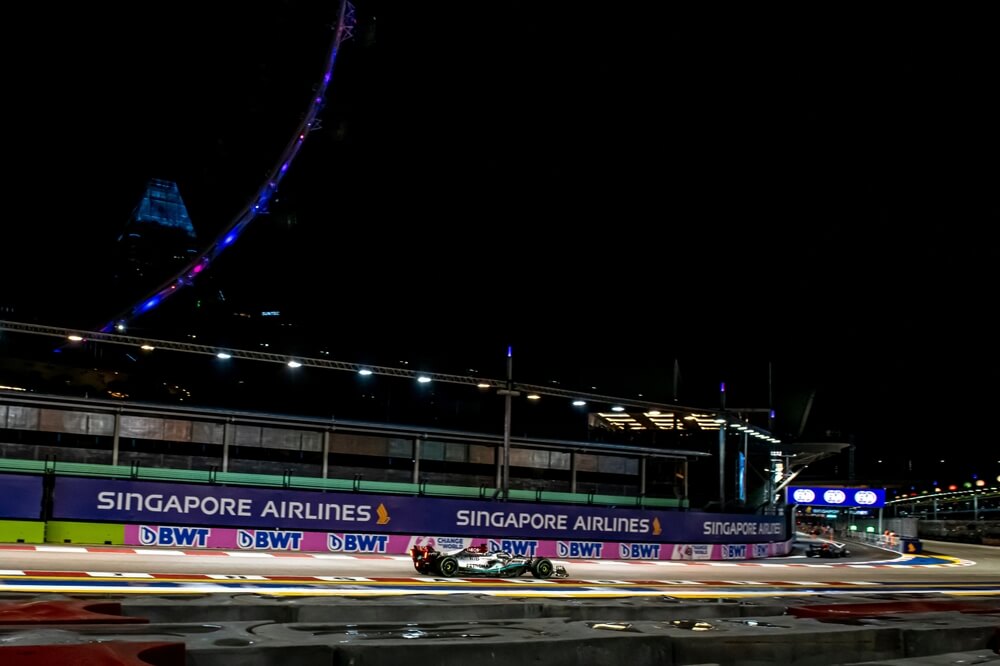There are no two ways about it: Formula 1 is a dangerous sport and one of the reasons is the dangerous tracks.
Going over 200 mph while battling wheel-to-wheel is never safe, which is one of the reasons F1 drivers are paid so well.
However, everything is relative, and with the sport visiting more locations than ever before, it is unavoidable that some tracks are riskier than others.
In this article, we will look at the top 7 most dangerous Formula 1 tracks, visiting both historic and modern circuits, so buckle up!
7. Red Bull Ring, Austria
The Red Bull Ring, located in the high hills of Spielberg in Austria’s Styrian province, hosted its first Grand Prix in 1970.
With big elevation changes and hard braking zones in the first sector, drivers are especially prone to accidents during the first lap of the Grand Prix.
Add to that a high-speed middle and final sector with little run-off area, and you have a recipe for thrilling battles, but also for spectacular crashes.
However, this circuit is not on our list because of its current danger; in fact, it is not even that dangerous when compared to other modern tracks.
However, this circuit is not on our list because of its current danger; in fact, it is not even that dangerous when compared to other modern tracks.
Ivan Berets, semi-professional racing driver
No, we put this circuit here because of its history.
The track, originally known as the Österreichring (Austria Ring in German), was built in 1969 and was dangerous even by those standards.
Despite being 10m wide in all places, the track was very fast, with every corner being a fast sweeper. Many agreed that the Österreichring was dangerous, particularly the Bosch Kurve, a 180-degree banked downhill right-hand corner with almost no run-off area that saw entry-speeds of over 200mph.
Even up until the final Austrian Grand Prix there in 1987, some of the track was just road with little to no protection.
6. Circuit de Spa-Francorchamps, Belgium
Few circuits are as iconic and incredible as Spa-Francorchamps.
The original course, designed by Jules de Thier and Henri Langlois Van Ophem in 1920, used public roads to connect the Belgian towns of Francorchamps, Malmedy, and Stavelot.
The circuit hosted its first car race in 1922, and the now-famous 24 Hours of Francorchamps race debuted in 1924.
It is the longest track on the current Formula 1 calendar, at just over 4.3 miles, with a mix of fast and slow corners, the highest elevation of any F1 track (335 feet), and dangers around every corner.
But the circuit makes our list because of one series of corners; Eau Rouge-Raidillon.
And I think what makes it special is, in general, the elevation. It's like a big wall, you arrive there with a lot of speed, and at some point you are blind. So all those small details makes it, I would say, special. If you turn a tiny bit too late, or too early, you can have a big crash.
Sébastien Buemi, racing driver for Toyota Gazoo
It is without a doubt one of the most famous pieces of tarmac in motorsports history, having been the subject of hundreds of posters, photos, and legendary racing moments.
There was Mark Webber’s incredible overtake on Fernando Alonso in 2011 and Kimi Räikkönen’s overtake on Michael Schumacher in 2012, both of which were some of the best moves in the sport’s history.
But it’s also extremely dangerous, and the site of many high-speed crashes (some ending in tragedy). It was the site of Anthoine Hubert’s death in 2019, and has since undergone several safety improvements. Nowadays, the number of deaths in Formula 1 is much lower compared to the past.

5. Circuit de Monaco, Monaco
The Monaco Grand Prix, the Crown Jewel of Formula 1, is perhaps the most iconic and highly decorated race on the calendar.
The streets of the principality have long been Formula 1’s ultimate driving challenge, dating back to 1929 and the early days of Grand Prix racing.
It’s the most pure, unadulterated, and downright primal tracks, with no margin for error as drivers attempt to navigate its narrow, bumpy streets.
The track’s configuration has remained largely unchanged since its inception in 1929: and as a city circuit, it is closely linked to the principality’s road system. In fact, what little changes there were were almost entirely related to redefinitions of the town’s main roads.
This results in a track that is completely unsuitable for Grand Prix racing, which is what makes it so special.
The race is held on a narrow course laid out in the streets of Monaco, with many elevation changes and tight corners as well as the tunnel, making it one of the most demanding tracks in Formula One.
In spite of the relatively low average speeds, the Monaco circuit is a dangerous place to race due to how narrow the track is and the race often involves the intervention of a safety car.Wikipedia.com
Imagine looking out your apartment window and seeing a Formula 1 race taking place below you; that is exactly what the Circuit de Monaco is.
Because of the tight and twisty nature of the circuit, it favors driver skill and precision above all else. However, because the course is so narrow and dangerous, there is very little overtaking, as demonstrated by the 2021 Monaco Grand Prix, which had only one overtake in a 78-lap race.
Nelson Piquet famously compared the race to “riding a bicycle around your living room.”
The famous tunnel section is reported to be the most difficult for drivers to deal with due to the quick transition from light to dark, then back to light at one of the course’s fastest points.
The circuit is widely acknowledged to be more dangerous than other Formula 1 circuits. Michael Schumacher, who won the race 5 times, stated before the 2012 Grand Prix that the additional risk is “justifiable once a year.”
In fact, according to current FIA criteria, the track would not be allowed on the calendar.
4. Autodromo Nazionale de Monza, Italy
The Autodromo Nazionale di Monza is one of the world’s fastest circuits and has hosted the Italian Grand Prix since 1949.
The track was first completed in July 1922 and officially opened on September 3rd, 1922.
It had a loop section and a road section at the time. The most serious Italian racing accident to date occurred there in 1928, killing driver Emilio Materassi and 27 spectators at the Italian Grand Prix.
Today, it is known as the fastest circuit on the Formula 1 calendar, with drivers exceeding 215mph on the long straights and using full power for more than 75% of the lap. In 2020, Lewis Hamilton set the fastest F1 lap ever when he averaged 164.267mph over the course of a qualifying lap.
When your closing speed is so big here, and someone's going from full-left to full-right, you can't pick a side. It's actually dangerous.
Although the rule of the book says it is fine, it is dangerous and it's hard to pick a side. We were definitely quick enough to get past.Jordan King, Formula 2 racing driver
The circuit’s high-speed nature is what makes it so dangerous, and the first chicane is especially prone to creating big crashes due to the sheer amount of speed drivers must bleed off before entering the tight series of corners.
There have been many notable incidents during recent years.
There was Marcus Ericsson’s high-speed rollover on the main straight, which occurred when his DRS failed to close while entering the first corner, causing him to lose control and swerve into the barrier.
Then there was the collision between Max Verstappen and Lewis Hamilton at the first chicane of the 2021 Grand Prix, a watershed moment in their season-long battle for the World Championship.
3. Marina Bay Street Circuit, Singapore
Singapore’s Marina Bay Street Circuit makes the podium position on our list for a very particular reason.
With a total of 21 safety car deployments in twelve races, the circuit has a unique record of having at least one safety car appearance in every race to date.
A combination of heat, humidity, and a race that consistently exceeds its two-hour time limit results in a serious workout for the body. Add to that the mental challenge of threading a car between concrete barriers at speeds of more than 180 mph, and the race in Singapore is truly unlike any other in Formula 1.
Each driver’s body will be fighting a losing battle against dehydration and heat stress throughout Sunday’s race. Aside from the obvious physical discomfort, they also have an impact on mental performance and concentration levels.
In terms of safety, I think that is one of the worst corners we have in the calendar because you have these big kerbs, big bumps.
Sebastian Vettel, Formula 1 racing driver
Even the most fit drivers are pushing themselves to their limits, increasing the likelihood of an accident. All of this creates a very unique combination of challenges, with drivers battling not only each other, but also the effects of Singapore’s harsh environment.
One striking example of that occured in 2014.
Kevin Magnussen, who was racing for McLaren at the time, received minor burns from his seat when hot air from the radiator leaked into the cockpit.
All of these difficulties make the Singapore Grand Prix more akin to desert survival than a Formula 1 race.
2. Baku City Circuit, Azerbaijan
The Baku City Street circuit has many dangers around the corner… literally.
Being a street circuit, there is no run-off area, so making a mistake can mean the end of your race and a significant bill for your team.
However, the Azerbaijan track makes our list for one specific reason.
The long straight on the Baku street circuit is one of the season’s fastest sections, with drivers expected to reach 207mph. While the speeds are dangerous on their own, the entrance to the pit lane makes this section even more scary.
2016 F1 champion Nico Rosberg explains why the end of the lap is the most dangerous in the sport in a video titled “How to Master the Baku Track.”
[It is] one of the most dangerous of the whole year, and it was quite scary.
Imagine something breaks on the car here. You're at 350 kph. On the left — just four meters to the left — there's just a wall, and it's facing you. If something breaks, and you're in that wall, it's the end; there's no more you.
This is one of the most scary places I've ever driven an F1 car in. To go by there just feels ridiculously wrong. But you have to try and blend it out.Nico Rosberg, former Formula 1 racing driver
Although some changes have been made to make the pit entry safer, this threat remains, and Baku remains on our list of the most dangerous tracks.
1. Nürburgring Nordschleife, Germany
There is no track more famous than the Nürburgring, full stop.
Its history goes back all the way to 1907, where the first Eifelrennen race was held on the one-off Taunus circuit, a 73-mile stretch of public roads starting between the towns of Wehrheim and Saalburg just north of Frankfurt.
Following the examples of Italy’s Monza and Targa Florio courses, the construction of a dedicated race track just south of the Nideggen circuit around the ancient castle of the town of Nürburg.
The track was finished in the spring of 1927 and served as a showcase for German automotive engineering and racing talent.
After WWII, the track hosted the German Grand Prix, which was held on the circuit’s northern loop, known as the Nordschleife. The Nürburgring Nordschleife is the world’s longest permanent circuit, with the F1 version stretching 14.189 miles.
However, with that record comes the burden of being one of the most dangerous, second only to Indianapolis in terms of F1 driver fatalities.
The Nürburgring. If you've spent any time reading about cars, you've probably heard the term. What is it? It's a merciless 13-mile track with terrifying twists, turns, and dips, and arguably the most dangerous race course in the world.
BusinessInsider.com
A look at the track reveals three factors that make it difficult for even the most experienced drivers: steep elevation changes, blind corners, and a lack of runoff areas.
The most famous incident on the Nürburgring Nordschleife occured in 1976. Niki Lauda, the reigning world champion and the only person to lap the entire 14.189-mile Nordschleife in under seven minutes, proposed to the other drivers that they boycott the track.
Lauda was concerned not only about the safety arrangements and the lack of marshals around the circuit, but also about the possibility of racing in a rainstorm.
It's difficult because it's very blind and it gets very tight. It has a very very very late apex, and people just dont expect that. Because they think, "Well, the turn should be over now." No, it gets tighter, tighter, tighter, and it's very blind. And you see a lot of accidents happen there.
Misha Charoudin is a racecar driver and a course instructor at Nürburgring
The other drivers voted against it, and the race proceeded. After a new magnesium component on his Ferrari’s rear suspension failed, Lauda crashed out of the left-hand kink before Bergwerk. He was badly burned because his car was still full of fuel on lap 2. Fortunately, the actions of fellow drivers Arturo Merzario, Guy Edwards, Brett Lunger, and Harald Ertl saved his life.
The German Grand Prix was moved to the Hockenheimring in 1977, and the old Nürburgring never hosted another F1 race again.
Conclusion
Formula 1 is the pinnacle of motorsport, but with that prestigious title comes the risk of driving the world’s fastest racing cars. But the fact that the sport will never be truly safe is what makes it so exciting.
The sheer variety of racing tracks that the F1 circus visits each year is part of what makes it so special, but we must remember that what we love has drawbacks, including increased risk to drivers.
7 most dangerous Formula 1 tracks:
- Nürburgring Nordschileife, Germany
- Baku City Circuit, Azerbaijan
- Marina Bay Street Circuit, Singapore
- Autodromo Nazionale de Monza, Italy
- Circuit de Monaco, Monaco
- Circuit de Spa-Francorschamps, Belgium
- Red Bull Ring, Austria
Article sources
- https://www.businessinsider.com/spa-francorchamps-sebastien-buemi-race-track-dangerous-2020-7?r=US&IR=T
- https://www.autosport.com/formula2/news/aitken-admits-dangerous-f2-monza-weaving-was-a-bit-naughty-4988966/4988966/
- https://www.reuters.com/article/motor-racing-prix-chicane-idINDEE88L04V20120922
- https://www.youtube.com/watch?v=aLQVZijK0nM
- https://www.businessinsider.com/nurburgring-most-dangerous-race-track-2019-9?r=US&IR=T




